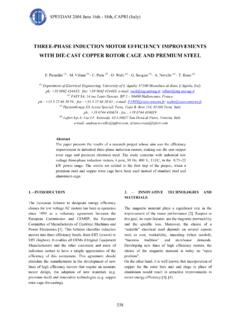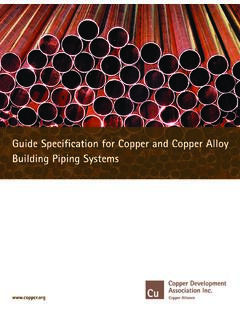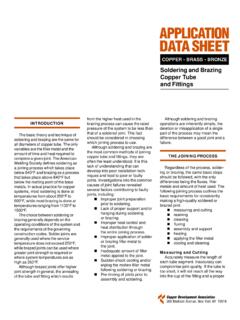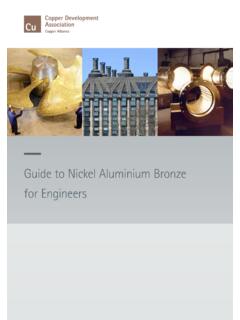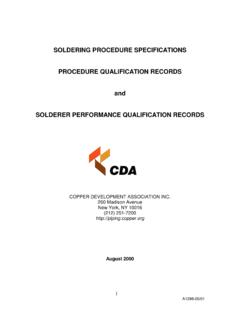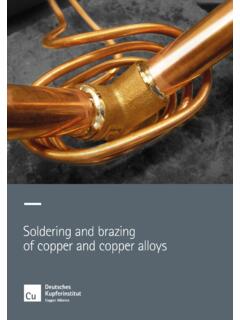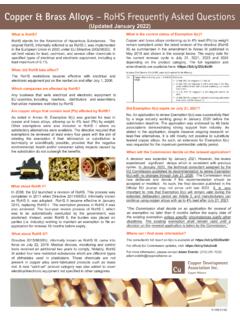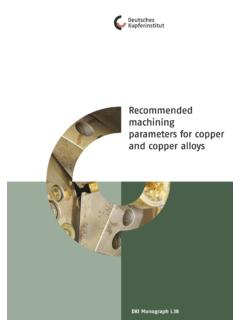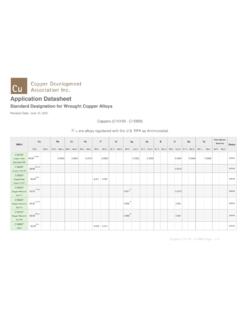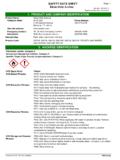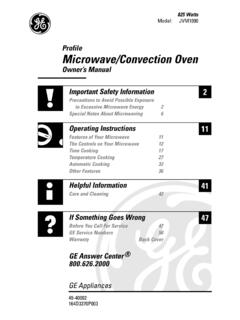Transcription of A Guide to Working With Copper and Copper Alloys
1 THE Copper ADVANTAGEA Guide to Working With Copper and Copper Introduction .. 3 Conductivity .. 4 Strength .. 4 Formability .. 4 Joining .. 4 Corrosion .. 4 Copper is Antimicrobial .. 4 Color .. 5 Copper Alloy Families .. 5II. Physical Properties .. 8 Properties .. 8 Electrical & Thermal Conductivity .. 8 III. Mechanical Properties .. 12 Tensile Properties .. 12 IV. Chemical Properties .. 15 Biological Importance .. 15 Color & Tarnishing .. 16 Corrosion Resistance .. 16 Stress Corrosion .. 17V. Antimicrobial Behavior .. 18 EPA Testing .. 18 Clinical Trials .. 19 Stipulations .. 19VI. Working With Copper Alloys .. 20 Commercial Product Forms .. 20 Hot Forming Processes .. 21 Extrusion .. 21 Forgings .. 21 Cold Forming Processes .. 21 VII. Joining .. 23 Soldering & 23 Flameless Joining.
2 24 CuproBraze .. 24 Welding .. 25 Metallurgical Bonding .. 25 Mechanical Fasteners .. 26 Adhesive Bonding .. 26 VIII. References .. 27 PREFACE The information in this Guide includes an overview of the well-known physical, mechanical and chemical properties of Copper , as well as more recent scientific findings that show Copper has an intrinsic antimicrobial property. Working and finishing techniques, alloy families, coloration and other attributes are addressed, illustrating that Copper and its Alloys are so adaptable that they can be used in a multitude of applications in almost every industry, from door handles to electrical circuitry to heat exchangers. Copper s malleability, machinability and conductivity have made it a longtime favorite metal of manufacturers and engineers, but it is its antimicrobial property that will extend that popularity into the future. This Guide describes that property and illustrates how it can benefit everything from common touch surfaces to HVAC coils.
3 History is rich with evidence of Copper s biocidal ability. For example, the ancient Egyptians, Greeks, Romans and Aztecs used Copper compounds for the treatment of disease and good hygiene and, much later, the hulls of British naval ships were encased in Copper to protect against biofouling. In support of the historical anecdotal evidence, recent laboratory testing has shown that Copper and Copper Alloys are effective antimicrobial materials. Copper , brass and bronze work effectively against the most troublesome antibiotic-resistant bacteria* including Methicillin-resistant Staphylococcus aureus (MRSA) and Vancomycin-resistant enterococcus (VRE), as well as other common harmful bacteria*. Copper is the only solid surface material registered by the Environmental Protection Agency to continuously kill bacteria* that pose a threat to human health. No other touch surface material has this kind of registration. This booklet will serve to answer immediate questions about using Copper and Copper Alloys in familiar ways and in new applications, as well as Guide the reader to sources of more in-depth information.
4 * Laboratory testing shows that, when cleaned regularly, Antimicrobial Copper kills greater than of the following bacteria within 2 hours of exposure: Methicillin-resistant Staphylococcus aureus (MRSA), Vancomycin-resistant enterococcus faecalis (VRE), Staphylococcus aureus, Enterobacter aerogenes, Pseudomonas aeruginosa, and E. coli O157:H7. Antimicrobial Copper surfaces are a supplement to and not a substitute for standard infection control practices. Like other antimicrobial products, they have been shown to reduce microbial contamination, but do not necessarily prevent cross contamina-tion; users must continue to follow all current infection control practices. I. INTRODUCTION3 Copper and Copper Alloys are widely used in a variety of products that enable and enhance our everyday lives. They have excellent electrical and thermal conductivities, exhibit good strength and formability, have outstanding resistance to corrosion and fatigue, and are generally nonmagnetic. They can be readily soldered and brazed, and many can be welded by various gas, arc and resistance methods.
5 They can be polished and buffed to almost any desired texture and luster. Pure Copper is used extensively for electrical wire and cable, electrical contacts and various other parts that are required to pass electrical current. Coppers and certain brasses, bronzes and Copper nickels are used extensively for automotive radiators, heat exchangers, home heating systems, solar collectors, and various other applications requiring rapid conduction of heat across or along a metal section. Because of their outstanding ability to withstand corrosion, coppers, brasses, bronzes and Copper nickels are also used for pipes, valves and fittings in systems carrying potable water, process water or other aqueous fluids, and industrial gases. Copper Alloys are also ideally suited where it is important to minimize bacterial* levels on touch surfaces. Because of their inherent ability to kill of bacteria* within two hours, more than 280 Copper Alloys have been granted public health registration by the Environmental Protection Agency (EPA).
6 This unprecedented registration recognizes Copper s inherent ability to continually kill bacteria* between regular cleanings, and aids in reducing infection-causing bacteria* on touch surfaces in hospitals, schools, offices and other public establishments. ConductivityOf all common metals, Copper possesses the highest rating for both electrical and thermal conductivity. High conductiv-ity coupled with intrinsic strength, formability and corrosion resistance make Copper Alloys unique as conductors of electricity making them ideal for connectors and other electrical/electronic products. StrengthCopper is a relatively soft and malleable metal with excel-lent formability, making it ideal for architectural applica-tions such as roofs, wall cladding, gutters and downspouts. Additions of other elements to Copper strengthen it and form Copper Alloys , including brasses, phosphor bronzes and Copper nickels. Copper Alloys possess tensile properties that exceed some aluminum Alloys and approach those of stainless steels, and can be used in a multitude of applica-tions.
7 Miniaturization of electronic devices and components has benefited from the high strength and moderate to high conductivities offered by specialty Copper Alloys . FormabilityCopper s exceptional formability is most readily illustrated by its ability to produce micron-sized wire with minimum softening anneals. In general, Copper Alloys exhibit increased strength proportional to the amount and the nature of the alloying element. In brasses, bronzes, nickel silvers, Copper nickels and other alloy families, strength is increased in proportion to the amount of cold work. Deep drawing, coining, stretching, and bending are common methods used to form components such as bathroom fixtures and other household products. Cartridge brass reflects the deep drawing characteristic of that alloy. Copper nickel tubes are generally formed from strip and then custom installed as condenser and Copper Alloys can be easily joined by the common methods soldering, brazing, welding, bolting, riveting, crimping and adhesive bonding.
8 The installation of plumbing fixtures and components provide examples of typical soldering and brazing applications. Welding techniques are routinely used for Copper and Copper nickel welded tube used in water delivery systems, heat exchangers and air-conditioning units. Additional information is found in Section VII of this Copper and its Alloys are widely used in many environments and applications because of their excellent corrosion resis-tance. Architectural fittings and fixtures made from Copper , brass and bronze continue to provide service in both indoor and outdoor environments. Copper Alloys corrode at negli-gible rates in unpolluted air, water and deaerated nonoxidiz-ing acids. Many Copper alloy artifacts have been found in nearly pristine condition after having been buried in the earth for millennia. Copper roofing has been found to cor-rode at rates of less than in ( ) in 200 years. Copper Alloys resist many saline solutions, alkaline solu-tions and organic chemicals. Typical applications where Copper and Copper Alloys provide superior service include indoor and outdoor archi-tectural components, freshwater supply lines and plumbing fixtures, heat exchangers and condensers, freshwater and seawater marine hardware, industrial and chemical plant process equipment, electrical wire and cable, printed circuit boards and industrial is AntimicrobialThe antimicrobial attributes of Copper and its Alloys are intrinsic and have been exploited for centuries.
9 Egyptians used Copper drinking vessels to clean water. The Hippocrates Collection, 460 to 380 , recommends the use of Copper for leg ulcers related to varicose veins. Pliny the Elder, 23 to 79, used Copper oxide with honey to treat intestinal worms. The Aztecs gargled with a mixture containing Copper to treat sore throats. Recent independent laboratory testing led the EPA to register Copper Alloys for their inherent ability to kill of the following listed organisms within two hours: Vancomycin-resistant enterococci (VRE), Staphylococcus aureus, Enterobacter aerogenes, Escherichia coli O157:H7, Pseudomonas aeruginosa and Methicillin-resistant Staphylococcus aureus (MRSA). No other solid metal surfaces have EPA registration to make public health Widely publicized statistics from the Centers for Disease Control and Prevention (CDC) estimate infections acquired in hospitals affect two million individuals every year and result in nearly 100,000 deaths annually. Results from a clinical trial in Birmingham, England, demonstrate that the use of Copper Alloys on certain surfaces in a busy hospital ward has the pot ential to reduce microbial contamination compared to non- Copper in the color of Copper Alloys stem primarily from differences in chemical composition.
10 Unalloyed coppers have a red tone. The addition of other elements causes a change toward yellow, bronze, silver or gray. These colors can then develop patinas when exposed to air. The degree of change depends upon the alloy chemistry and the composi-tion of the atmosphere. Copper Alloy FamiliesCopper Alloys are identified by the Unified Numbering System (UNS) which categorizes families of Alloys based upon their elemental make-up. Wrought products range from UNS C10000 through UNS C79999; cast products are assigned numbers between UNS C80000 and UNS in its pure, unalloyed state is soft, provides high electrical and thermal conductivity and has excellent corro-sion resistance. There are various grades of unalloyed cop-per, which differ in the amount of impurities they contain. Oxygen-free coppers are used specifically in applications requiring high conductivity and exceptional ductility. Brasses are Alloys made from Copper and zinc, they exhibit good strength and ductility and are easily cold worked, properties which improve with increased zinc content up to 35%.
